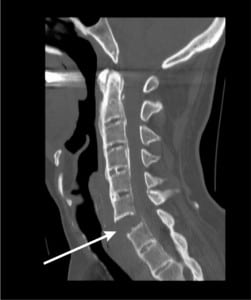| Author | Affiliation |
|---|---|
| Jennifer Carnell, MD | Alameda County Medical Center, Highland Hospital, Department of Emergency Medicine, Oakland, CA |
| Jahan Fahimi, MD | Alameda County Medical Center, Highland Hospital, Department of Emergency Medicine, Oakland, CA |
| Charlotte Page Wills, MD | Alameda County Medical Center, Highland Hospital, Department of Emergency Medicine, Oakland, CA |
A 66-year-old man with a history of ankylosing spondylitis presented to the emergency department as a trauma activation after a fall backward onto his sacrum from the bottom rung of a ladder. He initially complained of neck pain. On physical examination, midline lower cervical spine tenderness to palpation was present, but careful neurologic examination revealed no deficits. A CT scan of the cervical spine performed immediately after his arrival demonstrated an unstable fracture through areas of bony ankylosis with marked widening at C6–C7. He was admitted to the trauma service and subsequently underwent cervical spine fixation by the neurosurgical service.
Fractures occur most commonly in the cervical and thoracic spine, and fractures of the ankylosed spine are common as evidenced by a lifetime incidence of 14%.1 In this sagittal CT image of the cervical spine, both the typical bamboo spine appearance of ankylosing spondylitis and the fracture at C6–7 are evident. Because emergency medicine providers are often the first to evaluate patients after trauma or when they develop pain, it is important to recognize that the degree of trauma necessary to fracture the ankylosed spine is minimal. Many patients are unable to cite a specific causative trauma.2 Moreover, these fractures often result in neurologic complications and incomplete neurologic recovery. Imaging of the spine should be strongly considered in any patient with ankylosing spondylitis and new or unusual neck/back pain. Timely identification of unstable fractures is instrumental in avoiding adverse neurologic sequelae.

Footnotes
Supervising Section Editor: Rick A McPheeters, DO
Submission history: Submitted March 14, 2009; Revision Received June 11, 2009; Accepted June 15, 2009
Full text available through open access at http://escholarship.org/uc/uciem_westjem
Address for Correspondence: Jennifer Carnell, MD, Department of Emergency Medicine, Alameda County Medical Center, Highland Hospital, 1411 East 31st Street, Oakland, CA 94602
Email jencarnell@gmail.com
Conflicts of Interest: By the WestJEM article submission agreement, all authors are required to disclose all affiliations, funding sources, and financial or management relationships that could be perceived as potential sources of bias. The authors disclosed none.
REFERENCES
1. Mundwiler M, Siddique K, Dym J, et al. Complications of the spine in ankylosing spondylitis with a focus on deformity correction. Neurosurg Focus. 2008;24:1–9.
2. Vosse D, Feldtkeller E, Erlendsson J, et al. Clinical vertebral fractures in patients with ankylosing spondylitis. J Rheumatol. 2004;31:1981–5. [PubMed]


